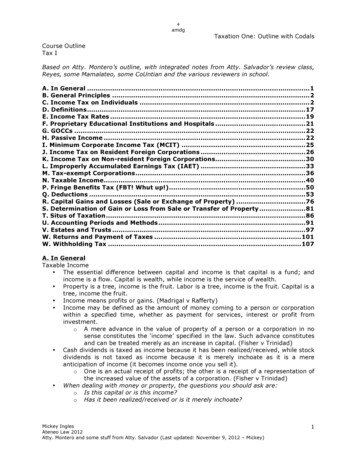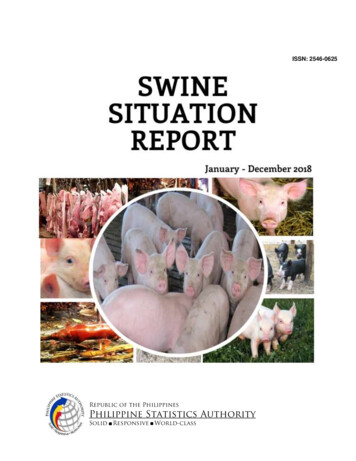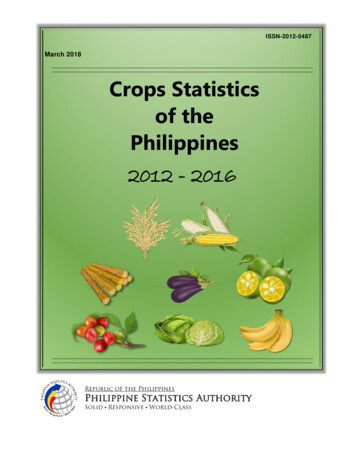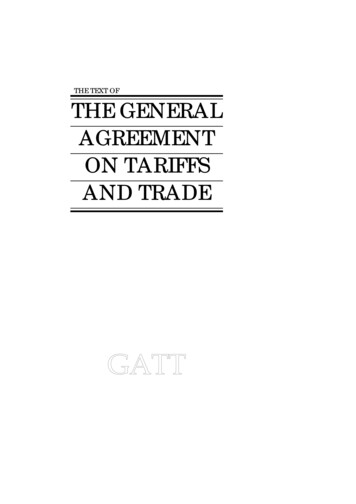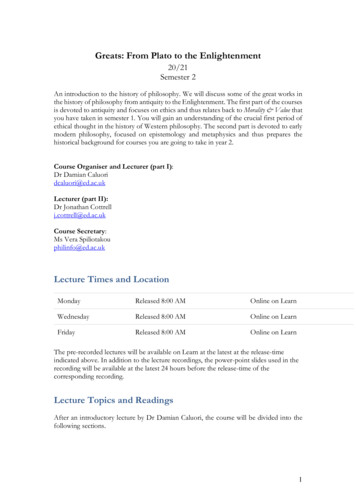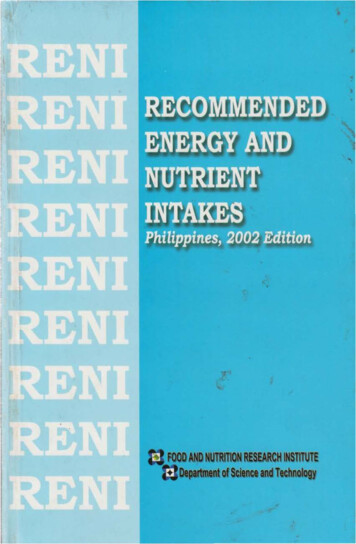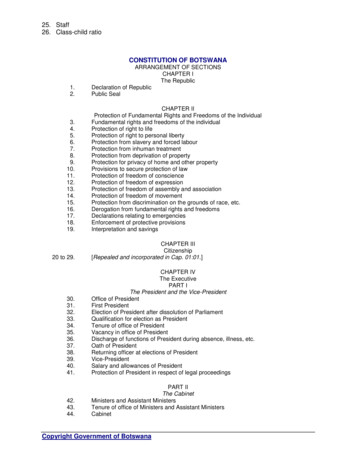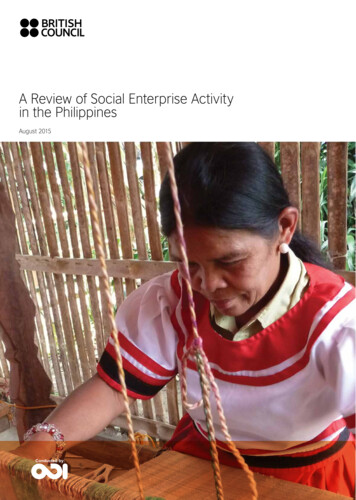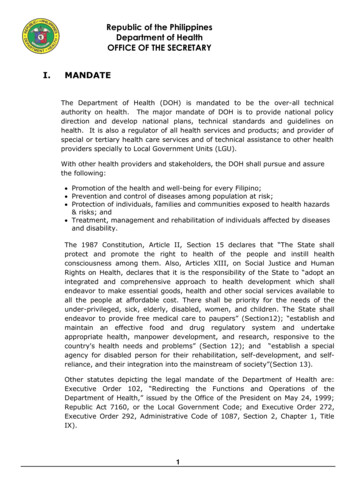
Transcription
Republic of the PhilippinesDepartment of HealthOFFICE OF THE SECRETARYI.MANDATEThe Department of Health (DOH) is mandated to be the over-all technicalauthority on health. The major mandate of DOH is to provide national policydirection and develop national plans, technical standards and guidelines onhealth. It is also a regulator of all health services and products; and provider ofspecial or tertiary health care services and of technical assistance to other healthproviders specially to Local Government Units (LGU).With other health providers and stakeholders, the DOH shall pursue and assurethe following: Promotion of the health and well-being for every Filipino; Prevention and control of diseases among population at risk; Protection of individuals, families and communities exposed to health hazards& risks; and Treatment, management and rehabilitation of individuals affected by diseasesand disability.The 1987 Constitution, Article II, Section 15 declares that “The State shallprotect and promote the right to health of the people and instill healthconsciousness among them. Also, Articles XIII, on Social Justice and HumanRights on Health, declares that it is the responsibility of the State to “adopt anintegrated and comprehensive approach to health development which shallendeavor to make essential goods, health and other social services available toall the people at affordable cost. There shall be priority for the needs of theunder-privileged, sick, elderly, disabled, women, and children. The State shallendeavor to provide free medical care to paupers” (Section12); “establish andmaintain an effective food and drug regulatory system and undertakeappropriate health, manpower development, and research, responsive to thecountry's health needs and problems” (Section 12); and “establish a specialagency for disabled person for their rehabilitation, self-development, and selfreliance, and their integration into the mainstream of society”(Section 13).Other statutes depicting the legal mandate of the Department of Health are:Executive Order 102, “Redirecting the Functions and Operations of theDepartment of Health,” issued by the Office of the President on May 24, 1999;Republic Act 7160, or the Local Government Code; and Executive Order 272,Executive Order 292, Administrative Code of 1087, Section 2, Chapter 1, TitleIX).1
Based on Executive Order 102, issued by the Office of the President in May 24,1999, the DOH is responsible for and serve as the: Lead agency in articulating national objectives for health, to guide thedevelopment of local health systems, programs and services; Direct service provider for specific programs that affect large segments of thepopulation, tuberculosis, malaria, schistosomiasis, HIV-AIDS and otheremerging infections and micronutrient deficiencies; Lead agency in health emergency response services, including referral andnetworking systems for trauma, injuries and catastrophic events; Technical authority in disease control and prevention; Lead agency in ensuring equity, access and quality of health care servicesthrough policy formulation, standards development and regulations; Technical oversight agency in charge of monitoring and evaluating theimplementation of health programs, projects research, training and services; Administrator of selected health facilities at sub-national levels that act asreferral centers for local health systems i.e., tertiary and special hospitals,reference laboratories, training centers, centers for health promotion, centerfor disease control, and prevention, regulatory offices among others; Innovator of new strategies for responding to emerging needs; Advocate for health promotion and healthy life styles for the generalpopulation; Capacity-builder of LGUs, the private sector, non-governmental organizations,peoples organizations, national government agencies in implementing healthprograms, services, through technical collaborations, logistical support,provision of grants and allocation and other partnership mechanism; Lead agency health and medical research; Facilitator of the development of health industrial complex in partnership withthe private sector to ensure self-sufficiency in the production of biologicals,vaccines and drugs and medicines; Lead agency in health emergency preparedness and response; Protector of standards of excellence in the training and education of health careproviders at all levels of the health care system; Implementer of the National Health Insurance Law; providing administrativeand technical leadership in health care financing; and Expressing national objectives for health to lead the progress of local healthsystems, programs and services.Essentially, the DOH has three specific roles in the health sector: leadership inhealth, enabler and capacity builder and administrator of specific servicesnamely, national and sub-national health facilities and hospitals serving asreferral centers, direct services for emergent health concerns requiringcomplicated technologies and assessed as critical for public welfare and healthemergency response services, referral and networking systems for trauma,injuries, catastrophic events, epidemics and other widespread public danger. Toaccomplish its mandate and roles the Department has the following power andfunctions based on Executive Order 102: Formulate national policies and standards for health;Prevent and control leading causes of death and disability;2
Develop disease surveillance and health information systems;Maintain national health facilities and hospitals with modern and advancedcapabilities to support local services;Promote health and well-being through public information and to provide thepublic with timely and relevant on health risks and hazards;Develop and implement strategies to achieve appropriate expenditurepatterns in health as recommended by international agencies;Develop sub-national centers and facilities for health promotion, diseasecontrol and prevention, standards, regulations and technical assistance;Promote and maintain international linkages for technical collaboration;Create the environment for the development of a health industrial complex;Assume leadership in health in times of emergencies, calamities, anddisasters and system failures;Ensure quality of training and health human resource development at alllevels of the health care system;Oversee financing of the health sector and ensure equity and accessibility tohealth services; andArticulate the national health research agenda and ensure the provision ofsufficient resources and logistics to attain excellence in evidenced-basedintervention for health.To perform these functions are the various central bureaus and services andsixteen (16) field offices called Centers for Health Development in every regionincluding specialty hospitals and regional hospitals and medical centers. It alsohave provincial health teams made up of DOH representatives to local healthboards and technical personnel for communicable disease control.II.VISION STATEMENTA Global Leader for attaining better health outcomes, competitive and responsivehealth care systems, and equitable health care financing (Figure A)III. MISSION STATEMENTTo guarantee equitable, sustainable and quality health for all Filipinos, especiallythe poor, and to lead the quest for excellence in health (Figure A).3
CORE VALUES:IntegrityExcellenceCompassionPeopleHealth GovernanceBetter Health OutcomesEquitable Health FinancingResponsive Health SystemsEmpowermentInternal ProcessesMISSION:To guarantee equitable,sustainable and qualityhealth for all Filipinos,especially the poor, andto lead the quest forexcellence in health.OrganizationVISION:A Global Leader forattaining better healthoutcomes, competitiveand responsive healthcare systems, andequitable health carefinancing.ResourcesDOHPathway toBetter HealthBy 2030SocialImpactEquityHigh Degree of Access and Utilization of HealthServices by the PublicAlign researchinitiatives, policies,systems, and planswith UHCStrengtheninformationmonitoring andevaluation systemsEnsure adequateand competent DOHpersonnelRationalizeallocation of budgetfor hospital, CHDand DOH programsEnhancestewardshiprole of DOH toimprovehealth sectorperformanceStrengthenpublic internalmanagementfor moreefficientspending forhealthGuaranteeaccountability inDOHEnsurerational useanddistribution ofhealthservices,facilities andtechnologiesProvide modern informationsystemImprove efficiencyon financialproceduresFigure 1: DOH Performance Governance System Framework4Ensuresustainablemanagementof DOH healthfacilities
IV. STRATEGIC THRUSTS AND PROGRAMSA. GOALS,OBJECTIVES, STRATEGIC THRUSTS & STRATEGIES1(Figure 2)From various health sector sectors reforms that were implemented in pastdecade, the current government shall continue addressing the problemson equity and access to critical quality health services. To successfullyimplement the Aquino Health Agenda (AHA), the Philippine health systemwill require the following components: enlightened leadership and goodgovernance practices; accurate and timely information and feedback onperformance; financing that lessens the impact of expenditures especiallyamong the poorest and the marginalized sector; competent workforce;accessible and effective medical products and technologies; andappropriately delivered essential services.Overall Goal: The implementation of Universal Health Care shall bedirected towards ensuring the achievement of the health system goals ofbetter health outcomes, sustained health financing and responsive healthsystem by ensuring that all Filipinos, especially the disadvantaged group inthe spirit of solidarity, have equitable access to affordable health care.General Objective: Universal Health Care is an approach that seeks toimprove, streamline, and scale up the reform strategies in Health SectorReform Agenda (HSRA) and Fourmula 1 (F1) for Health in order toaddress inequities in health outcomes by ensuring that all Filipinos,especially those belonging to the lowest two income quintiles, haveequitable access to quality health care.This approach shall strengthen the National Health Insurance Program(NHIP) as the prime mover in improving financial risk protection,generating resources to modernize and sustain health facilities, andimprove the provision of public health services to achieve the MillenniumDevelopment Goals (MDGs).A. The Aquino Health Agenda (AHA) is a focused approach to health reformimplementation in the context of HSRA and F1, ensuring that all Filipinosespecially the poor receive the benefits of health reform. AHA shall beattained by pursuing three strategic thrusts (Figure 2):1.Financial risk protection through expansion in NHIP enrollment andbenefit delivery – the poor are to be protected from the financialimpacts of health care use by improving the benefit delivery ratio ofthe NHIP;Lifted from Administrative Order 2010-0036 dated December 16, 2010, issued on January 3, 2010)15
2.3.Improved access to quality hospitals and health care facilities –government-owned and operated hospitals and health facilities willbe upgraded to expand capacity and provide quality services to helpattain MDGs, attend to traumatic injuries and other types ofemergencies, and manage non-communicable diseases and theircomplications; andAttainment of the health-related MDGs – public health programs shallbe focused on reducing maternal and child mortality, morbidity andmortality from TB and malaria, and the prevalence of HIV/AIDS, inaddition to being prepared for emerging disease trends, andprevention and control of non-communicable diseases.Better health outcomesResponsive health systemEquitable health financingFinancial ancingServiceDeliveryPolicy, standards& regulationImprovingaccess toquality healthfacilitiesHealth HumanResourceHealthInformationGovernancefor HealthFigure 2: Kalahatan PangkalusuganB. The six (6) strategic instruments shall be optimized to achieve the AHAstrategic thrusts:1.2.3.4.5.Health Financing – instrument to increases resources for health thatwill be effectively allocated and utilized to improve the financialprotection of the poor and the vulnerable sectorsService Delivery – instrument to transform the health servicedelivery structure to address variations in health service utilization andhealth outcomes across socio-economic variablesPolicy, Standards and Regulation – instrument to ensure equitableaccess to health services, essential medicines and technologies ofassured quality, availability and safetyGovernance for Health – instrument to establish the mechanisms forefficiency, transparency and accountability and prevent opportunitiesfor fraudHuman Resources for Health – instrument to ensure that allFilipinos have access to professional health care providers capable ofmeeting their health needs at the appropriate level of care6
6.Health Information – instrument to establish a modern informationsystem that shall:a. Provide evidence for policy and program developmentb. Support for immediate and efficient provision of health care andmanagement of province-wide health systemsC. The success of AHA shall be measured by the progress made inpreventing premature deaths, reduce maternal and newborn deaths,controlling both communicable and non-communicable diseases,improvements in access to quality health facilities and services andincreasing NHIP benefit delivery rate, prioritizing the poor and themarginalized (such as the Geographically Isolated and DisadvantageArea (GIDA) population, indigenous population, older persons,differently-abled persons, internally-displaced population, and people inconflict-affected areas). These performance measures are the results ofeffective interaction between families and health care providers (bothpublic and private) in local health systems.D. The DOH shall facilitate the implementation of the AHA by influencingthe manner by which Provinces and component LGUs, and Cities governlocal health systems.E. In implementing the Aquino Health Agenda, the DOH recognizes thatLGUs have the primary mandate to finance and regulate local healthsystems, including the provision of the right information to families andhealth provides.F. Consistent with the Presidential commitment zero-corruption in thegovernment, the implementation of UHC shall be founded onparticipatory governance, transparency and accountability at thenational, sub-national, and local government levels to be better respondto the health needs of all Filipinos.G. Broad and sustained participation among all stakeholders shall bepurposive, coordinative, harmonized and productive. UHC shall harnessthe strength of revitalized public-private partnership especially inservices needing heavy capital investments.H. UHC shall be client-centered and respond efficiently to the medicalneeds and social expectations consistent with accepted standards ofcare.I. In order to implement the Aquino health Agenda, the DOH shall engagelocal health systems (Provinces and their component LGUs, Cities,private and public health care provides, local partners, and families)through the formation of regional clusters based on their catchmentareas.7
The specific strategies supporting the strategic thrustsothers the following:include amongA. Financial risk protection through improvements in NHIP benefitdelivery shall be achieved by:1.Redirecting PhilHealth operations towards the improvement of thenational and regional benefit delivery ratios;2.Expanding enrolment of thecoverage;3.Promoting the availment of quality outpatient and inpatient services ataccredited facilities through reformed capitation and no balance billingarrangements for sponsored members, respectively;4.Increasing the support value of health insurance through the use ofinformation technology upgrades to accelerate PhilHealth claimsprocessing, etc.; and5.A continuing study to determine the segments of the population to becovered for specific range of services and the proportion of the totalcost to be covered/supportedpoor NHIP to improvepopulationB. Improved access to quality hospitals and other health carefacilities shall be achieved by:1.A targeted health facility enhancement program that shall leveragefunds for improved facility preparedness to adequately manage themost common causes of mortality and morbidity, including trauma;2.Provision of financial mechanisms drawing from public-privatepartnerships to support the immediate repair, rehabilitation andconstruction of selected priority health facilities;3.Fiscal autonomy and income retention schemes for governmenthospitals and health facilities;4.Unified and streamlined DOH licensure and PhilHealth accreditation forhospitals and health facilities; and5.Regional clustering and referral networks of health facilities based ontheir catchment areas to address the current fragmentation of healthservices in some regions as an aftermath of the devolution of localhealth services.C. Health-related MDGs shall be attained by:1.Deploying Community Heath Teams that shall actively assist families inassessing and acting on their health needs;2.Utilizing the life cycle approach in providing needed services, namelyfamily planning; ante-natal care; delivery in health facilities; essential8
newborn and immediate postpartum care; and the GarantisadongPambata package for children 0-14 years of age;3.Aggressively promoting healthy lifestyle changes to reduce noncommunicable diseases;4.Ensuring public health measures to prevent and control ofcommunicable diseases; and adequate surveillance and preparednessfor emerging and re-emerging diseases; and5.Harnessing the strengths of inter-agency and inter-sectoralcooperation to health especially with the Department of Education andDepartment of Social Welfare and the Department of Interior and LocalGovernment.9
2/F Building 1, San Lazaro Compound, Rizal Avenue, Sta. Cruz, 1003 ManilaTrunk Line 651-7800 local 1111/1107/1125/1132; Direct Line: 711-6070; 711-9502; 711-9503;912-5244Fax: 743-1829 URL: http://www.doh.gov.ph; e-mail: osec@doh.gov.ph10
with UHC Strengthen information monitoring and evaluation systems Enhance stewardship role of DOH to improve health sector performance Strengthen public internal management for more efficient spending for health Ensure rational use and distribution of health services, facilities and technologies Ensure sustainable management of DOH health


